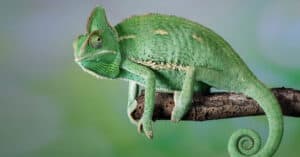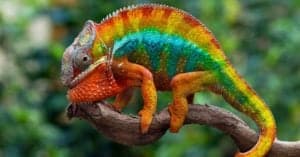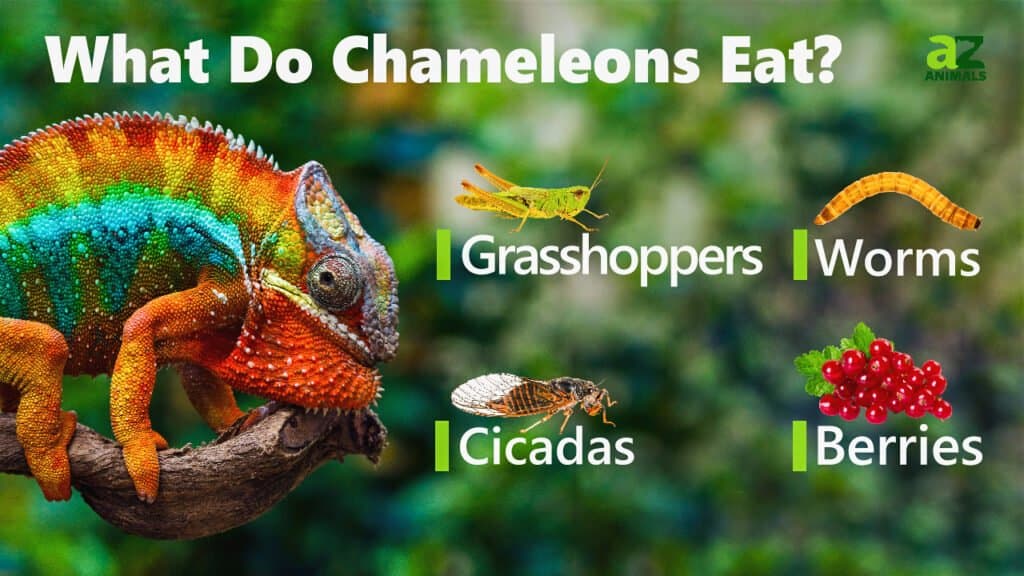
Chameleons, a source of wonder due to their remarkable ability to blend into the environment around them, are a member of the reptile family. Their skin is made of one superficial layer on top and beneath it are cells containing nanoscale guanine crystals. These photonic crystals to change colors and make it easier for them to hunt prey and hide from predators. They are known for growing throughout their lives and shedding their skin in parts unlike snakes that shed their skin at once. They have a prehensile tail that they use to wrap around the tree branch to keep them secure.
They mainly live in African rainforests and savannas and can sometimes be found in Europe, the Middle East, and Asia. In this article, you’ll learn what chameleons eat, how they hunt, and much more!
What Do Chameleons Eat?
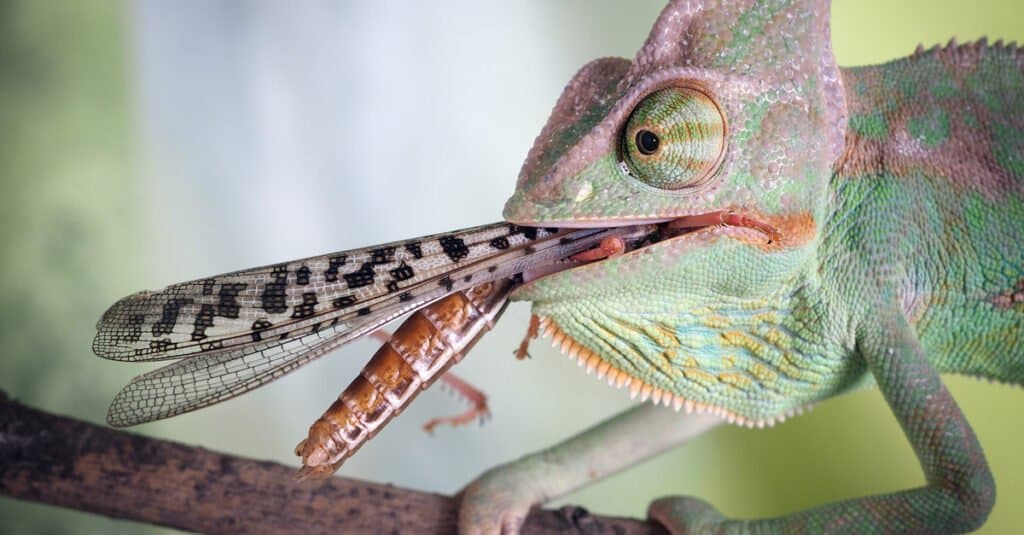
A chameleon eating an
insect
©Irina Kozorog/Shutterstock.com
What do chameleons eat? Chameleons are insectivorous reptiles that commonly eat insects such as flies, crickets, grasshoppers. However, due to their environment, which can be food-scarce, they will also opportunistically consume vegetation from time to time too.
Chameleons’ diet is mainly made up of small insects, which are the primary source of protein. Greens like dandelions and escarole are also a part of their diet and provide a good source of hydration, vitamins, and essential minerals.
A Complete List of What Chameleons Eat
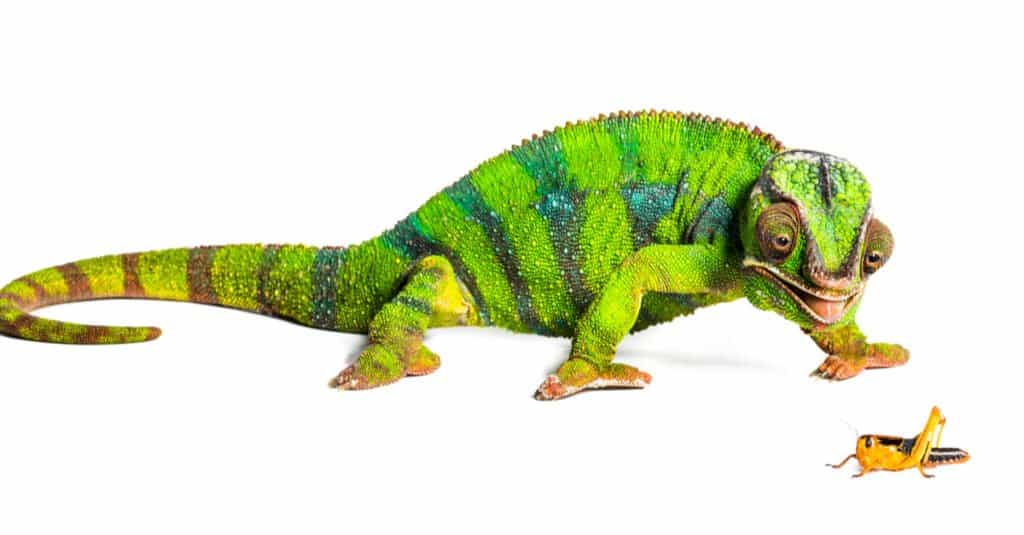
A chameleon gets ready to eat a grasshopper
©Eric Isselee/Shutterstock.com
Chameleons usually eat a healthy mix of insects and plants. Larger chameleons can even eat other animals like small birds and other small reptiles.
Chameleons primarily eat foods like:
- Grasshoppers
- Crickets
- Silkworms
- Flies
- Cicadas
- Grasshoppers
- Snails
- Leaves and other plants
- Locusts
- Worms
- Caterpillars
- Berries
- Apples
- Bananas
- Persimmons
- Dandelions
What Do Different Types of Chameleons Eat?
Chameleons’ diet relies on their size. Smaller species like the veiled chameleon consume primarily small insects and vegetation. Larger chameleons such as the Malagasy giant chameleon can eat larger insects, small birds, and other reptiles.
How Much Do Chameleons Eat?
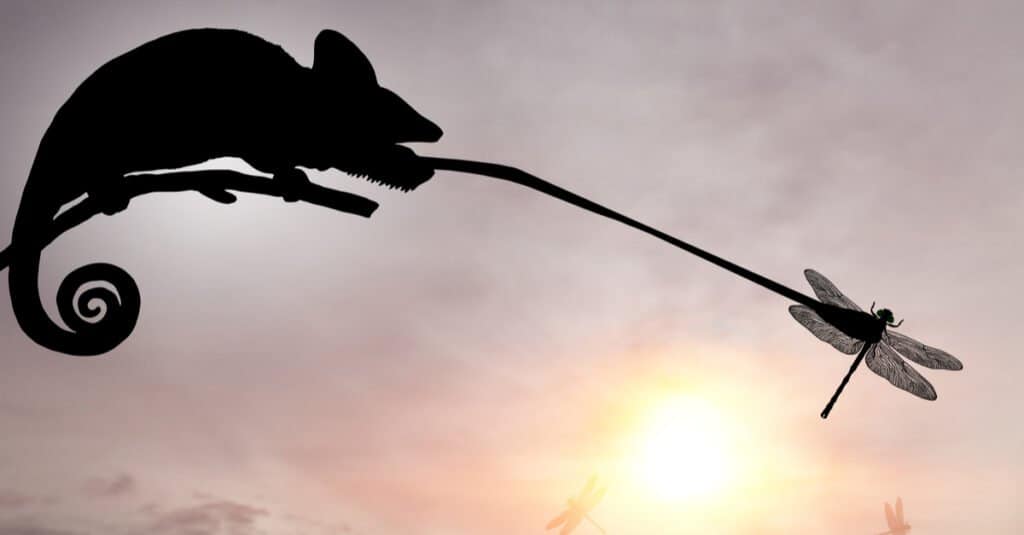
A chameleon eating a
dragonfly
at sunset
©Gwoeii/Shutterstock.com
The amount of food that chameleons consume depends on their age.
Until their first birthday, chameleons require more food than adults. In the wild, their food variety can be scarce, so they will eat as much as they can when they can find it. While in captivity, baby chameleons eat anywhere from 12-18 small insects a day, usually spread out into two feedings.
Adult chameleons are opportunistic eaters in the wild, which means they eat as often as they can find prey. If they can’t find food, they can survive for many weeks without eating as long as they have access to water. In captivity, they eat around 3-4 insects a day.
Chameleons do not drink water from pools in the forest floor in the wild or dishes of water in captivity. Instead, they prefer to drink water droplets from leaves or water that drips from leaves after a rainstorm.
How Do Chameleons Hunt?
What do chameleons eat and what do they hunt? Chameleons have excellent eyesight that allows them to see their prey from up to 10 yards away. Their eyes also move independently of one another and can see a full 360 view of the world around them, which allows them to search for and locate prey quickly.
Chameleons move very slowly to approach their prey. Once they are within a close distance, they quickly shoot out their sticky tongues to capture their meal in a snap. Some chameleon’s tongues go from 0 to 60 miles per hour in a hundredth of a second!
Up Next…
- How to Choose the Best Substrate for Your Reptile’s Terrarium: Keeping a reptile as a pet? Find out how you can create the best environment for them to thrive in.
- 10 Mind-Blowing Chameleon Facts!: Want to know more about chameleons? Read these facts that will amaze you.
- Are All Reptiles Cold-Blooded?: Are all reptiles cold blooded? Learn more about reptiles and their nature in this post.
The photo featured at the top of this post is © Irina Kozorog/Shutterstock.com
Thank you for reading! Have some feedback for us? Contact the AZ Animals editorial team.




